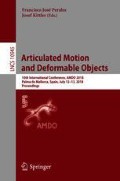Abstract
Leishmaniasis is considered a neglected disease that causes thousands of deaths annually in some tropical and subtropical countries. There are various techniques to diagnose leishmaniasis of which manual microscopy is considered to be the gold standard. There is a need for the development of automatic techniques that are able to detect parasites in a robust and unsupervised manner. In this paper we present a procedure for automatizing the detection process based on a deep learning approach. We train a U-net model that successfully segments leismania parasites and classifies them into promastigotes, amastigotes and adhered parasites.
Access this chapter
Tax calculation will be finalised at checkout
Purchases are for personal use only
References
Farahi, M., Rabbani, H., Talebi, A., Sarrafzadeh, O., Ensafi, S.: Automatic segmentation of leishmania parasite in microscopic images using a modified CV level set method. In: Proceedings of the SPIE Seventh International Conference on Graphic and Image Processing, vol. 9817 (2015)
Krizhevsky, A., Sutskever, I., Hinton, G.E.: Imagenet classification with deep convolutional neural networks. In: Advances in Neural Information Processing Systems, pp. 1097–1105 (2012)
Mehanian, C., Jaiswal, M., Delahunt, C., Thompson, C., Horning, M., Hu, L., McGuire, S., Ostbye, T., Mehanian, M., Wilson, B., Champlin, C., Long, E., Proux, S., Gamboa, D., Chiodini, P., Carter, J., Dhorda, M., Isaboke, D., Ogutu, B., Oyibo, W., Villasis, E., Tun, K.M., Bachman, C., Bell, D.: Computer-automated malaria diagnosis and quantitation using convolutional neural networks. In: 2017 IEEE International Conference on Computer Vision Workshop (ICCVW), pp. 116–125 (2017)
Ouertani, F., Amiri, H., Bettaib, J., Yazidi, R., Ben Salah, A.: Adaptive automatic segmentation of leishmaniasis parasite in indirect immunofluorescence images. In: Proceedings of the 36th Annual International Conference of the IEEE Engineering in Medicine and Biology Society (EMBC) (2014)
Ouertani, F., Amiri, H., Bettaib, J., Yazidi, R., Ben Salah, A.: Hybrid segmentation of fluorescent leschmania-infected images using a watersched and combined region merging based method. In: Proceedings of the 38th Annual International Conference of the IEEE Engineering in Medicine and Biology Society (EMBC) (2016)
Penas, K.E., Rivera, P.T., Naval, P.C.: Malaria parasite detection and species identification on thin blood smears using a convolutional neural network. In: 2017 IEEE/ACM 10th International Workshop on Cooperative and Human Aspects of Software Engineering (CHASE), pp. 1–6 (2017)
Quinn, J.A., Nakasi, R., Mugagga, P.K.B., Byanyima, P., Lubega, W., Andama, A.: Deep convolutional neural networks for microscopy-based point of care diagnostics. In: Proceedings of the 1st Machine Learning in Health Care, MLHC 2016, Los Angeles, CA, USA, 19–20 August 2016, pp. 271–281 (2016)
Ronneberger, O., Fischer, P., Brox, T.: U-Net: convolutional networks for biomedical image segmentation. In: Navab, N., Hornegger, J., Wells, W.M., Frangi, A.F. (eds.) MICCAI 2015. LNCS, vol. 9351, pp. 234–241. Springer, Cham (2015). https://doi.org/10.1007/978-3-319-24574-4_28
Sudre, C.H., Li, W., Vercauteren, T., Ourselin, S., Jorge Cardoso, M.: Generalised dice overlap as a deep learning loss function for highly unbalanced segmentations. In: Cardoso, M.J., Arbel, T., Carneiro, G., Syeda-Mahmood, T., Tavares, J.M.R.S., Moradi, M., Bradley, A., Greenspan, H., Papa, J.P., Madabhushi, A., Nascimento, J.C., Cardoso, J.S., Belagiannis, V., Lu, Z. (eds.) DLMIA/ML-CDS -2017. LNCS, vol. 10553, pp. 240–248. Springer, Cham (2017). https://doi.org/10.1007/978-3-319-67558-9_28
Vazquez Noguera, J.L., Legal Ayala, H., Schaerer, C.E., Rolon, M.: Mathematical morphology for counting trypanosoma cruzi amastigotes. In: IEEE XXXIX Latin American Computing Conference (2013)
WorldHealthOrganization: Leishmaniasis. fact sheet. Updated March 2018. http://www.who.int/mediacentre/factsheets/fs375/en/
Yazdanparast, E., Dos Anjos, A., Garcia, D., Loeuillet, C., Shahbazkia, H.R., Vergnes, B.: INsPECT, an open-source and versatile software for automated quantification of (leishmania) intracellular parasites. In: PLOS Neglected Tropical Diseases, vol. 8 (2014)
Acknowledgments
This work has been developed in the framework of the project TEC2016-75976-R, financed by the Spanish Ministerio de Economía, Industria y Competitividad and the European Regional Development Fund (ERDF). We gratefully acknowledge the support of the Center for Cooperation and Development to the group of neglected diseases at UPC. We also give special thanks to Dr. Cristina Riera, Dr. Roser Fisa and Dr. Magdalena Alcover, from the parasitology Section of the Biology, Healthcare and the Environment Department of the Pharmacy Faculty at Universitat de Barcelona advising this work with their knowledge on the Leishmaniosi parasite. We thank the Characterization of Materials Group at UPC to let us use its microscope equipment. Finally we thank Sofia Melissa Limon Jacques for her related work during her Degree Project.
Author information
Authors and Affiliations
Corresponding author
Editor information
Editors and Affiliations
Rights and permissions
Copyright information
© 2018 Springer International Publishing AG, part of Springer Nature
About this paper
Cite this paper
Górriz, M., Aparicio, A., Raventós, B., Vilaplana, V., Sayrol, E., López-Codina, D. (2018). Leishmaniasis Parasite Segmentation and Classification Using Deep Learning. In: Perales, F., Kittler, J. (eds) Articulated Motion and Deformable Objects. AMDO 2018. Lecture Notes in Computer Science(), vol 10945. Springer, Cham. https://doi.org/10.1007/978-3-319-94544-6_6
Download citation
DOI: https://doi.org/10.1007/978-3-319-94544-6_6
Published:
Publisher Name: Springer, Cham
Print ISBN: 978-3-319-94543-9
Online ISBN: 978-3-319-94544-6
eBook Packages: Computer ScienceComputer Science (R0)

